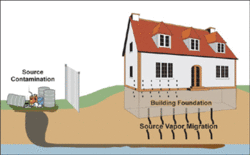
If you have recently been told, probably by the EPA or a state agency, that there is a possibility of vapor contamination in your neighborhood, what does that mean and what should you do now?
First of all, what is vapor intrusion?
Vapor intrusion can happen when the groundwater in your neighborhood is contaminated with a chemical or chemicals known as volatile organic compounds like TCE, PCE, vinyl chloride, benzene, or toluene. These chemicals can turn into a gas and come back up through the soil and get inside homes, contaminating the air that people are breathing. That can be a serious threat to your health and is called vapor contamination.
So, what do you do now? Test
If it is determined that the groundwater in your neighborhood is contaminated with one of these volatile organic compounds, and especially if the groundwater is shallow–less than 40 feet or so–you must insist that there be testing to see if the contamination is “vaporizing”. This testing–called soil gas sampling or testing–will check to see if the chemicals in that groundwater are turning into vapor and rising up to the surface and threatening your home.
Who should pay to do that testing?
The polluter. Why? Because that testing is very expensive and usually beyond the means of most homeowners. You need to insist that the polluter who spilled the chemicals that contaminated the groundwater, pay for the testing. Alternately, your EPA or state regulator can finance the testing, because it’s expensive and complicated, and you need someone who has experience with it.
Should you give the EPA or polluter access to your property?
Once it is decided who will do the testing, the polluter or the EPA will ask your permission to come into your yard and do vapor intrusion testing, to see if the chemicals in the groundwater are vaporizing. Should you give your permission? The answer is absolutely, yes. I mention this because frequently the families that I work with are so angry at the polluter and the government agencies–when they find out that a chemical is contaminating their groundwater and maybe has been for years–that their first instinct is to say “I’m not letting the polluters or the EPA on my property. I don’t trust them.” But I want you to give permission because you need to know the answers to the tests. Why? Because you need to know the results of the tests to protect yourself and your family.
What does vapor testing look like?
Basically, soil gas testing consists of an implement that looks like a large pole with holes cut into the sides being pushed down into the ground to collect the air that is in between the soil particles underground. This machine will collect air samples from air pockets in the soil, and then those samples will be sent to a laboratory to be tested for volatile organic compounds. If the test comes back positive–even if the sample has been taken out in your yard or near the street–then that means that dangerous chemicals, such as TCE, PCE or vinyl chloride, are rising up and threatening to get inside the spaces inside homes. And if those chemicals are detected in soil gas testing in your neighborhood, you know that there is a problem, and you need to insist on protection right away.
How can your family be protected from vapors?
If vapor contamination is found, you need a vapor mitigation system for your home. Vapor mitigation systems make sure that what is coming up from the groundwater in gas form is rerouted so that it does not get inside your home. The polluter or the EPA should provide you with a vapor mitigation system.
Is one test for vapor enough?
What happens if the first tests come back and no dangerous chemicals have been detected: does that mean you are safe? It does not. Remember, as long as the groundwater in your neighborhood is contaminated with volatile organic compounds, there is a threat that the chemicals will vaporize and come into your home. You can’t be satisfied that there isn’t a threat of vapor contamination until–in my opinion–you get at least 6-8 negative tests over an extended period of time such as a year or two. It is too easy for a gas to elude one single test, but it is unlikely to elude 4 or more tests, so you want multiple tests to be sure.
Why not test inside your home first?
Now, why wouldn’t you test inside your home first, because that is where your family is breathing the air? Why test the soil for vapor? The reason is that science has proven that testing inside homes is not terribly reliable. Why is this? Because you are testing for a gas and gas moves so quickly around a home that it can be hard to detect, and what we have seen over time is that there are a lot of false negatives in indoor testing. Experience tells us that soil gas testing is more accurate.
Don’t take a wait and see attitude
We now know that vapor contamination can be a serious threat in previously contaminated areas that were for a time considered mitigated. If volatile organic compounds are found anywhere in your yard or near your home in soil gas testing, that means that vapor is a threat to get inside your home. You don’t need to wait any further or do any more testing before insisting on the installation of a vapor mitigation system that will protect your home against the infiltration of these dangerous vapors.

"*" indicates required fields